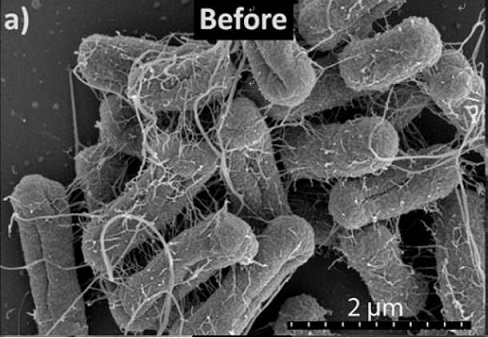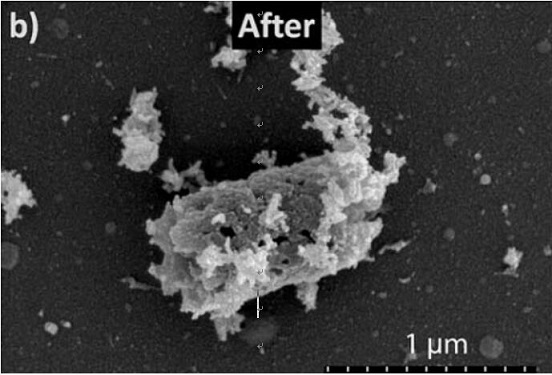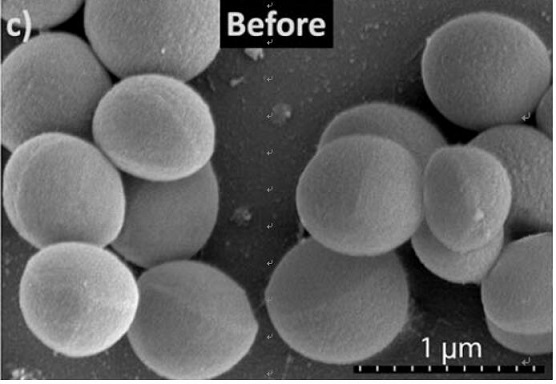Application of bismuth trioxide as bactericide
A technology of bismuth trioxide and fungicide, which is applied in the direction of application, biocide, disinfectant, etc., and can solve the problems of copper fungicide's poor effect, application restrictions, and limited application range, etc.
- Summary
- Abstract
- Description
- Claims
- Application Information
AI Technical Summary
Problems solved by technology
Method used
Image
Examples
Embodiment 1
[0027] Example 1: The antibacterial substance bismuth trioxide (CAS registration number 1304-76-3), when nanometer-sized particles or micron-sized particles are used alone, can kill multidrug-resistant Gram-negative bacteria and Gram-negative bacteria. Lambert-positive bacteria, among them, micron-sized bismuth trioxide can be directly purchased commercially.
[0028] And the preparation method of nano bismuth trioxide is as follows:
Embodiment 2
[0029] Example 2: At room temperature, weigh 14.00 g of sodium bismuthate and put it into a 250 ml Erlenmeyer flask, add 80 ml of deionized water, and use a polytetrafluoroethylene rotor. The Erlenmeyer flask was fixed in an oil bath on a heating stirrer, and the system was taupe at this time. Afterwards, 5 mmol / ml aqueous HCl solution was added dropwise under ultrasonication until the pH was adjusted to 1, at which time the color of the system became lighter. Continue ultrasonic stirring at 80°C for 2h. After that, when the temperature of the reaction system drops to room temperature, centrifuge the reaction system at 4200rpm for 8 minutes, measure the pH of the supernatant, if the supernatant is acidic, add deionized water, stir the system evenly, and continue centrifugation under the same conditions . If the supernatant is neutral, collect the precipitate, wash once with deionized water, and collect the product. Put the product in a 100-degree oven to dry, and at this ti...
Embodiment 3
[0030] Example 3: At room temperature, weigh 14.00 g of sodium bismuthate and put it into a 250 ml Erlenmeyer flask, add 25 ml of deionized water and a Teflon rotor. Then drop 100mL of HNO 3 (5mmol / ml) solution, stirring at room temperature for 2h, will slowly precipitate out. The precipitate was collected and then washed with HNO 3 (5 mmol / ml) solution, followed by deionized water. Dry the product in a 100 degree oven. Afterwards, the product is placed in a tube furnace and calcined at 5°C per minute to 340°C for 2 hours in an atmosphere of 4% hydrogen and 96% nitrogen. After cooling, nanometer bismuth trioxide is obtained, which is a light white yellowish powder solid.
PUM
| Property | Measurement | Unit |
|---|---|---|
| length | aaaaa | aaaaa |
| width | aaaaa | aaaaa |
Abstract
Description
Claims
Application Information
 Login to View More
Login to View More - R&D
- Intellectual Property
- Life Sciences
- Materials
- Tech Scout
- Unparalleled Data Quality
- Higher Quality Content
- 60% Fewer Hallucinations
Browse by: Latest US Patents, China's latest patents, Technical Efficacy Thesaurus, Application Domain, Technology Topic, Popular Technical Reports.
© 2025 PatSnap. All rights reserved.Legal|Privacy policy|Modern Slavery Act Transparency Statement|Sitemap|About US| Contact US: help@patsnap.com



